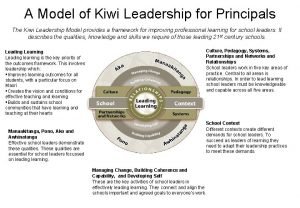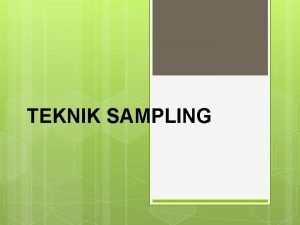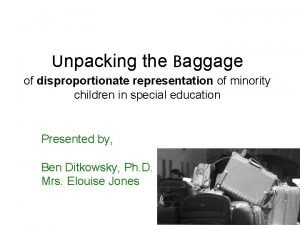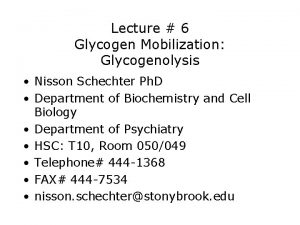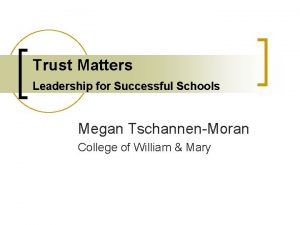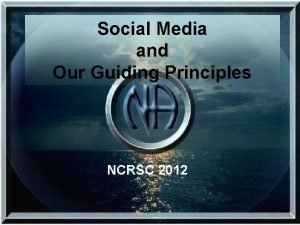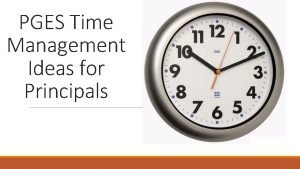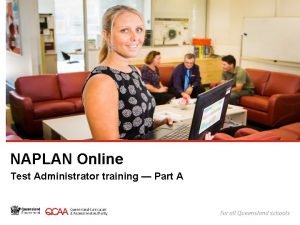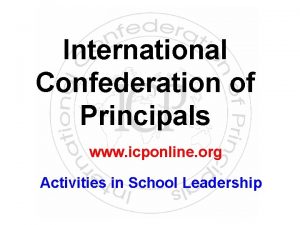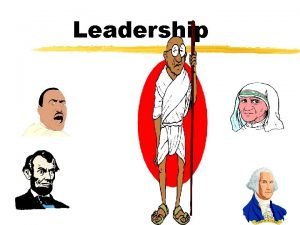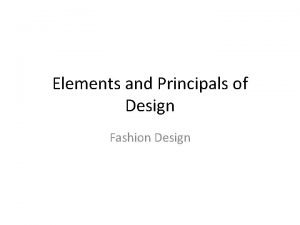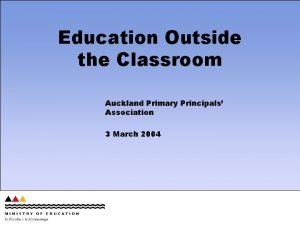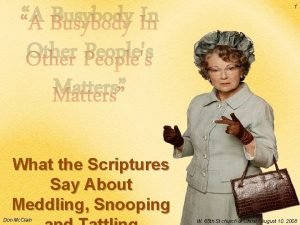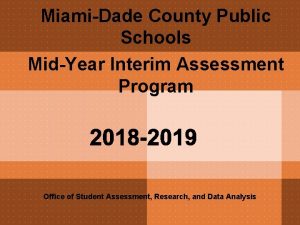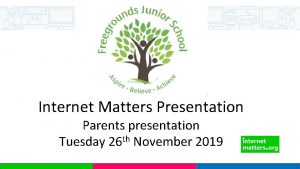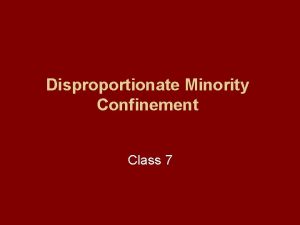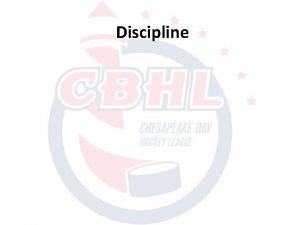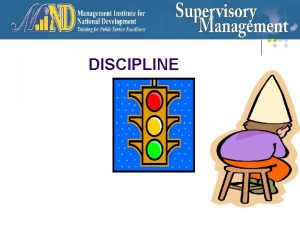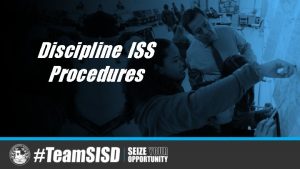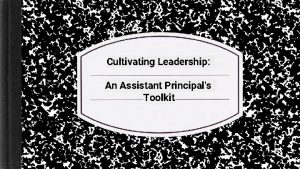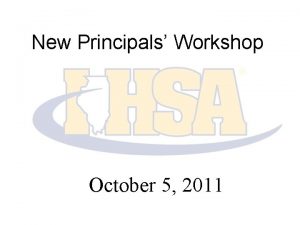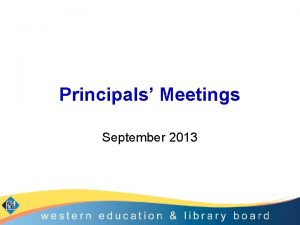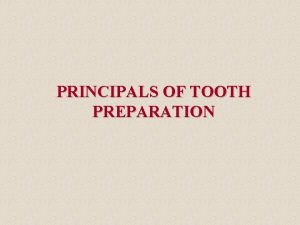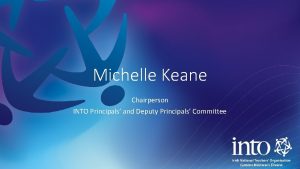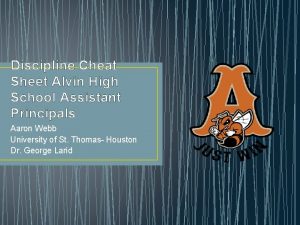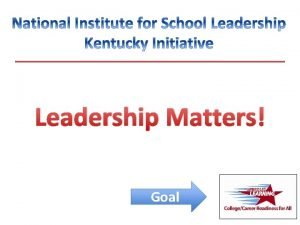Leadership Matters in Reducing Disproportionate Discipline COSA Principals




























- Slides: 28

Leadership Matters in Reducing Disproportionate Discipline COSA Principals & Teacher Leaders Conference October 2015 John Lenssen

Key Themes Gain background and focus for why disproportionate discipline and exclusionary practice is a priority Changing school climate and culture Explore key leadership skills and moves

What Is Discipline For? Order Learning Safety Fairness Reconnection Moral Authority Teachers Culture Life Skills Autonomy Students Behavior Change

“What Discipline is For: Connecting Students to the Benefits of Learning” Pedro Noguera Students who are behind academically, who are more likely to be students of color, are also more likely to engage in disruptive behavior, sometimes out of frustration or embarrassment. Children who suffer from abuse or neglect at home or who are harassed and teased by their peers are also more likely to misbehave. Since poverty rates are higher among racial minorities in the United States, students of color are more likely to exhibit behavior problems because of unmet needs. In many schools, it is common for the neediest students to be disciplined and for the needs driving their misbehavior to be ignored.

“Authentically striving for equity requires interruption of current thinking, systems, and constructs, as well as behaviors. ” - June 2013 Bay Area Coalitions for Equitable Schools Lenssen & Shigeoka

Cultural Lens Bias? “Teachers carry into the classroom their personal cultural background. They perceive students, all of whom are cultural agents, with inevitable prejudice and preconception. Students likewise come to school with personal cultural backgrounds that influence their perceptions of teachers, other students, and the school itself. Together students and teachers construct, mostly without being conscious of doing it, an environment of meanings enacted in individual and group behaviors, of conflict and accommodation, rejection and acceptance, alienation and withdrawal. ” (Spindler, 1994) June 2013 Lenssen & Shigeoka

Deconstructing (Leaders facilitate these conversations) For what behaviors do teachers refer students to …? Why do teachers refer students to …? What are the intended outcomes for referring students to …? Why do schools suspend students?


Exclusionary and punishment practices may appear to “work” in the short term – Remove student – Provide relief to teachers, students, administrator – Attribute responsibility for change to student and/or others (family)

What We Know About Exclusion “Exposure to exclusionary discipline has been shown, not to improve school outcomes, but in fact to be associated with higher rates of school dropout. ” Skiba, Peterson and Williams, 1997 Ekstrom, Goertz, Pollack, & Rock, 1986 Wehlage & Rutter, 1986 Sprick, Borgmeier, Nolet, (2002)

Russ Skiba Center for Evaluation and Educational Policy, Indiana University For what type of infractions are students getting suspended? “Looking across studies of school discipline, it is clear that school suspension tends not to be reserved for serious or dangerous behaviors. The majority of offenses for which students are suspended appear to be non-violent, lessdisruptive (than fighting) offenses. ”

Big Ideas • Office Referrals, Suspension and Expulsion from school have been used to “punish” students, alert parents, and protect other students and school staff members but there are unintended consequences – Referrals, suspensions and expulsions may exacerbate academic deterioration – When students are provided with no educational alternative, student alienation, delinquency, crime, and substance abuse may ensue – Social, emotional, and mental health support for students can decrease the need for referrals, suspension and expulsion

Oregon Law Limits expulsion to conduct that poses a threat to health or safety, repeated behaviors that have not responded to other interventions, and expulsions mandated by law. Keeping students in class as much as possible in order to maximize their opportunities to learn Creating and maintaining a positive learning environment for all students

U. S. Department of Education Issues Guiding Principles: A Resource Guide for Improving School Climate and Discipline January 2014 Dear Colleague Letter Guidance letter prepared with partners at the Department of Justice describing how schools can meet their obligations under federal law to administer student discipline without discriminating on the basis of race, color, or national origin.

Behind the Guidance Package: The Data In 2011, nationwide: 3 million out-of-school suspensions 100, 000+ students expelled Students lost “hundreds of thousands” of hours of instructional time • Students of color, students with disabilities are “far more likely” to be removed from class • African-American students are three times more likely to be suspended/expelled, often for similar offenses • Most exclusionary actions are for non-violent offenses • Suspensions lead to drop-outs, police contact

Guiding Principle 1: Climate and Prevention (1) Engage in deliberate efforts to create positive school climates (2) Prioritize the use of evidence-based strategies like PBIS (3) Promote social and emotional learning to complement academic skills and encourage positive behavior (4) Provide regular training and supports to all school personnel (5) Collaborate with local mental health, child welfare, law enforcement, and juvenile justice agencies to align resources, prevention strategies, and intervention services (6) Ensure that any school-based law enforcement officers’ roles focus on improving school safety and reducing inappropriate referrals to law enforcement

Guiding Principle 2: Clear, Appropriate, and Consistent Expectations and Consequences (1) Set high expectations for behavior and adopt an instructional approach to school discipline. (2) Involve families, students, and school personnel in the development and implementation of discipline policies or codes of conduct, and communicate those policies regularly and clearly. (3) Ensure that clear, developmentally appropriate, and proportional consequences apply for misbehavior. (4) Create policies that include appropriate procedures for students with disabilities and due process for all students.

Guiding Principle 3: Equity and Continuous Improvement (1) Train all school staff to apply school discipline policies, practices, and procedures in a fair and equitable manner that does not disproportionately impact students of color, students with disabilities, or other students at risk for dropout, trauma, or social exclusion. (2) Use proactive, data-driven, and continuous efforts, including gathering feedback from families, students, teachers, and school personnel in order to prevent, identify, reduce, and eliminate discriminatory discipline and unintended consequences.

From What We Know About Reducing Suspension Rates for Students of Color (OLN NWREL – Nishioka 2012) Positive, caring teacher-student relationships High expectations for students Structured school and classroom environments Parental involvement Teacher and student resources Preventive and proactive school discipline practices

Schools That Reduce Disruption and Delinquency • Shared values regarding school mission and purpose (admin, staff, families, students) • Clear expectations for learning and behavior • Multiple activities designed to promote pro-social behavior and connection to school traditions • A caring social climate involving collegial and supportive relationships among adults and students • Students have valued roles and responsibilities in the school

A new move We need to address the root causes of behaviors that lead to suspension and expulsion and provide alternative disciplinary actions – These practices might be called “restorative discipline, ” adapted from the concepts and practices of “balanced and restorative justice” commonly used in juvenile and adult corrections and treatment programs.

Restorative Justice is an approach to dealing with conflicts that is not punitive but emphasizes accountability and reconciliation of the offender with the larger community In schools, RJ can change discipline into a learning opportunity for students RJ in schools is linked to a much larger RJ movement in the country

Critical Assumptions of RJ Bad behavior is defined best as a violation of people, not law or rule. Offenders should be accountable not only to authorities but to those whom they have harmed. Victims and communities are given a direct role in seeking justice. Justice should balance the needs of victims, offenders, communities and authorities.

Three Questions of Restorative Justice Retributive Justice What is the harm that was done? What is the law (rule or policy) that was broken? How can that harm be repaired? Who broke that law? Who is responsible for this repair? How should they be punished?

Another Move Implicit Bias Training Increase Awareness De-Biasing Focus on Situation and Context Change Systems and Structures New Skills (Practice)

Multidimensional View of Bias (Kent Mc. Intosh UO) Racial Bias Disproportionate Discipline Situation Dangerous Decision Points Subjective Behavior Hunger Vague Discipline System Fatigue Prior Incidents Unfamiliar with Student

Leadership Moves Generate Sufficient Dissatisfaction Develop and Support Leadership Team Make it a Priority Commit to Measurable Outcomes Identify What Works Ongoing Professional Development Resources Monitor, Evaluate, Revise

Thank You! John Lenssen and Associates lenssenj@mindspring. com 541 905 3292
 Kiwi leadership for principals
Kiwi leadership for principals Jenis jenis sampel
Jenis jenis sampel What causes dwarfism in humans
What causes dwarfism in humans Pase vs hannon
Pase vs hannon Bials test
Bials test R and t state
R and t state Barfoid test
Barfoid test Reducing vs non reducing sugar
Reducing vs non reducing sugar Trust matters leadership for successful schools
Trust matters leadership for successful schools Cosa sono le scienze umane e cosa studiano
Cosa sono le scienze umane e cosa studiano I fusi orari cosa sono
I fusi orari cosa sono Ncrsc
Ncrsc Time management for principals
Time management for principals Naplan locked down browser
Naplan locked down browser Apapdcl
Apapdcl Universal principals
Universal principals Brings together a composition with similar units
Brings together a composition with similar units Principals of design
Principals of design Primary flavors
Primary flavors Auckland primary principals association
Auckland primary principals association South african principals association
South african principals association Capable but cautious performer
Capable but cautious performer Transactional leadership vs transformational leadership
Transactional leadership vs transformational leadership What is adaptive leadership theory
What is adaptive leadership theory Every second matters
Every second matters Don't be a busybody in other people's matters
Don't be a busybody in other people's matters Why data governance matters
Why data governance matters Performance matters dadeschools
Performance matters dadeschools Fraping cyberbullying definition
Fraping cyberbullying definition
